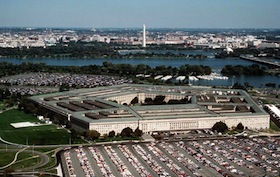Cuts Coming to Pentagon and Labs, But How Much?
Defense Spending Cut in Debt Deal Unclear - Josh Rogin in Foreign Policy
August 2, 2011
Featured Image
Today's top nuclear policy stories, with excerpts in bullet form.
Stories we're following today: Tuesday, August 2, 2011.
Defense Spending Cut in Debt Deal Unclear - Josh Rogin in Foreign Policy [link]
- Despite the White House's claim that the new debt deal would cut $350 billion from defense spending over the next ten years, there are no specifics in the bill on defense cuts -- and no way to tell what the final cuts will be.
- What the bill does is set spending caps for "security" spending, which the administration defines as defense, homeland security, intelligence, nuclear weapons, diplomacy, and foreign aid. There's no breakdown that defines which of these agencies get what.
- The debt deal caps fiscal 2012 security spending at $684 billion, which means a cut of about $4.5 billion compared to fiscal 2011 levels. That money could come from defense, or it could come from the State Department, the Department of Homeland Security, the National Nuclear Safety Administration, or another department. Nobody knows.
Lab Budgets at Risk in Debt Deal - John Fleck in the Albuquerque Journal [link]
- The National Nuclear Security Administration, which funds nuclear weapons work at Los Alamos and Sandia labs here in New Mexico, will be vulnerable to budget cuts as part of the deal worked out yesterday to raise the federal debt ceiling.
- The Obama administration had requested big budget increases for the NNSA’s nuclear weapons work, and Congress appeared ready to go along. What’s unclear now is whether that support will hold under significant pressure as part of this deal for overall cuts in defense/security spending.
The Enemy of Iran’s Enemy - Barbara Slavin in Foreign Policy [link]
- Despite the alarmist headlines, no one should have been shocked by last week's U.S. Treasury Department designation of a Syrian based in Iran as a conduit for sending money and personnel to al Qaeda.
- Intelligence experts say it's quite possible that al Qaeda is moving money and personnel between the Middle East and Afghanistan and Pakistan through Iran, but that does not amount to a formal alliance and the Obama administration should not overstate the links.
- There is a danger that such rhetoric will only give new ammunition to the hawks and increase pressure on the administration to take military action -- or risk looking weak if it does not.
Is Iran Really After a Nuclear Bomb? - Patrick Disney in The Atlantic [link]
- One question has dominated the U.S. conversation regarding Iran for years: how long until they get the bomb? … The problem is, it's an impossible question. It might also be the wrong one to ask.
- The really interesting question … is not when will Iran have the bomb, but rather why don't they already, and how can we keep it that way?
- ... an Iranian decision to acquire nuclear weapons would almost surely place the regime in greater short-term danger … An Iranian bomb could also greatly add to the country's enemies list and significantly reduce its international support.
A Hybrid of France and China Is a Good Model - Alejandro Sueldo in The Moscow Times [link]
- Russia must accept the futility of maintaining and building a sizable nuclear force and recognize that its security would be better served if more resources were allocated for military reform and developing conventional weapons that are a more credible deterrent and repellant to potential conventional aggressions.
- Although Russia has already reduced its nuclear arsenal to below the limits set by New START, it is working to build new missile submarines, a strategic bomber and strategic cruise and ballistic missiles. In addition, it has announced the development of a new heavy, liquid-fueled, multiple independently targetable re-entry vehicle warhead.



